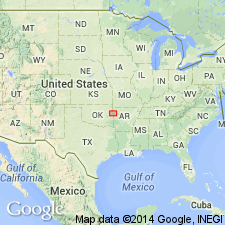
- Usage in publication:
-
- Braggs Member*
- Modifications:
-
- Named
- Dominant lithology:
-
- Limestone
- Shale
- AAPG geologic province:
-
- Arkoma basin
- Chautauqua platform
Summary:
Named as the basal member of the Sausbee Formation (new). Type area is on both sides of Arkansas River near Webber Falls Reservoir. Probably named for town of Braggs. Occurs in Muskogee and Cherokee Cos, OK, Chautauqua platform and east in OK to Sequoyah and western Adair Cos, Arkoma basin. Facies changes occur eastward in Adair Co, and nomenclature applied to equivalent rocks changed to Hale Formation and lower part of Bloyd Shale. Names Hale and Bloyd were applied in earlier reports to rocks named Braggs in this report. Unconformably overlies Pitkin Limestone. Underlies and intertongues with the newly named Brewer Bend Limestone Member of Sausbee. Consists of fine- to coarse-grained skeletal calcarenite with pelmatozoan and bryozoan fragments and interbedded calcareous to noncalcareous and silty dark gray shale with locally abundant brachiopod, bryozoan, and coral debris. Locally has quartz sandstone in lower part. Ranges from 12.8 to 53.3 m thick. Cross section. Stratigraphic chart. Fossiliferous (colony corals, conodonts, goniatites). Deposited as a shallow, open-marine carbonate in Early Pennsylvanian, early Morrowan time.
Source: GNU records (USGS DDS-6; Denver GNULEX).
For more information, please contact Nancy Stamm, Geologic Names Committee Secretary.
Asterisk (*) indicates published by U.S. Geological Survey authors.
"No current usage" (†) implies that a name has been abandoned or has fallen into disuse. Former usage and, if known, replacement name given in parentheses ( ).
Slash (/) indicates name conflicts with nomenclatural guidelines (CSN, 1933; ACSN, 1961, 1970; NACSN, 1983, 2005, 2021). May be explained within brackets ([ ]).

